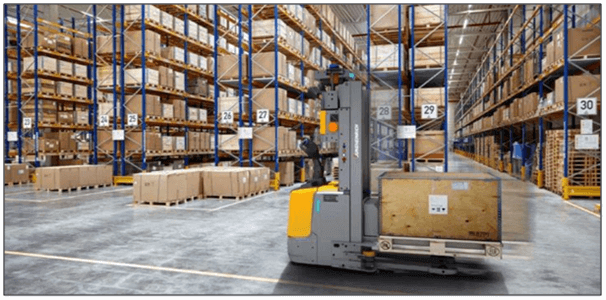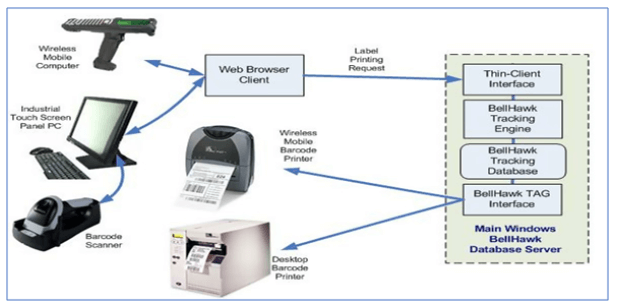In the Integrated logistics industry, Radio Frequency (RF) technology has entered the reality. Both employers, and employees can look forward for a cohesive working environment with the modern technology. As such, Radio Frequency Identification Device (RFID) has many advantages and benefits as the technology helps to streamline the working flow, provide the accuracy of inventories, exact delivery destination and wastage of man-hours. This article discusses how the RF technology can concatenate several physical assets towards integrated logistics.

Table of Contents
Radio Frequency Identification (RFID) Technology
RFID is a wireless technology that allows for tracking and matching of shipments. Basically, the system has two basic parts: tags and readers. Firstly, the reader gives off radio waves and gets signals back from the RFID tag, and while the tag uses radio waves to communicate its identity and information. It is also meaning of keeping a track of shipments using digital encoded tags and a digital database that contains information about the tagged shipments. In another word, RFID technology is similar to barcoding. In reality, RFID technology will be advantage for integrated logistics.

Assimilation of RFID in Warehouse
Most of the companies need a large warehouse space to hold the shipments. Warehouse must have the basic operational flow in the warehouse operations too. The main processes will be Inbound and Outbound functions that stimulate the daily operations. Beside receiving, and shipping there are some miscellaneous functions such as stock storage, order status, paper processes, sorting, cycle-count, loading/ unloading and customer service are part of the daily processes. To achieve the effective practice for a large warehouse space, equipment and manpower, RFID technology will be the only solution.

Inbound Integration with RFID
There are multiple benefits that RFID can reduce and eliminate wastage in the logistics industry. An automatic identification using electronic tags that have a microchip and antenna, is a small improvement from the barcode technology. As the Barcodes offer a limited report, but there is an automated form of data entry by using RFID technology.In the long-term, RFID will offer complete visibility throughout manufacturing, shipping, and warehousing with an automated form of data entry that will capture from the tags that were attached to the incoming shipments. The RFID tag will be able to receive data faster than barcodes which gives more information pertaining to the products, and uses less manpower in today’s working life. RFID tags are less expensive, do provides standardize data and the tags are more efficient for inbound process.
Barcoding System
Barcodes are most prominently featured in warehousing operations. From the asset management to both inventory and fixed assets, barcodes are increasingly being used. Just as physical shipments that can be assessed and tracked, information and data can be captured by a quick scanning to the laptop or system. The barcodes can assist the warehouse operations in tracking the inventory in/out of the stock or production. It also maintains a lean turnover ratio with the exact figure and eliminates excess in the inventory stock. The barcodes can assist to create the comprehensive check in and checkout system for fixed assets. It will be an aid to track the assets’ depreciation, maintenance, and repair. Moreover, the barcodes will so useful for the warehousing functions.

Warehouse Scanning Device
RF scanners are used together with barcodes in the warehouse operations. The scanners allow the warehouse employees to find inventory, pick inventory, and do cycle-count by scanning the part numbers in the locations. Therefore, the employees do not need a hard copy to bring to the area for checking. Hard copies might not be advisable to bring along as the employees might lose it or even misplace the copies during the cycle-count. Due to ignorance, employees have to do double count again. In addition, scanners with mobile computers allow employees for more visibility of the inventory. Hence, the scanners do increase productivity by generating a mobile interface for picking orders, receiving inventory and even cycle-count. Handheld devices such as RF scanners, are very useful for their portability and relatively long-range in warehouse.

Wireless Voice Directed Picking
For a voice-directed warehouse, employees can wear a headset that will connect to a small wearable computer, similar to a size of a Walkman, which advises the employees where to go, and what to do by using verbal prompts. Employees can confirm their tasks by speaking to the pre-defined commands and reading the confirmation codes that are printed on locations or even on the products throughout the warehouse facility. The speech recognition software running on the wearable computer ‘understands’ the employees’ response in the warehouse facility. Typically, Voice-directed warehousing is used to eliminate paperwork or mobile computer-based systems that require employees to read the instructions, scan barcodes or key-enter information to confirm their tasks. By freeing employees’ hands and eyes, a voice-directed system will improve efficiency, and more precise data. As the voice-directed warehouse was originally used in picking orders, warehouse functions from receiving and put-away to replenishment and shipping. Whilst the process can be coordinated by voice systems, it will be much easier and faster for the warehouse employees.
The full content is only visible to SIPMM members
Already a member? Please Login to continue reading.
References
Clarus Software Ltd. (2018). “Cloud Based Warehouse Management System”. Retrieved from https://www.claruswms.co.uk/rfid-benefits-wms/, accessed 29/03/2021.
Hollingsworth. (2020). “Guide to RFID Shipping and Fulfillment”. Retrieved from https://www.hollingsworthllc.com/guide-rfid-shipping-fulfillment/, accessed 29/03/2021.
Marvin Edward. DSLM (2019). “RFID Technology for Orthopaedical Warehousing and Distribution”. Retrieved from SIPMM: https://publication.sipmm.edu.sg/rfid-technology-orthopaedic-warehousing-distribution/, accessed 29/03/2021.
Naresh Kumar. DSLM. (2019). “Digital Technology for Warehouse Productivity”. Retrieved from SIPMM: https://publication.sipmm.edu.sg/digital-technology-warehouse-productivity/, on 29/03/2021.
Paul A. Myerson. (2015). “RFID: More Than Just A Better Barcode”. Retrieved from https://www.inboundlogistics.com/cms/article/rfid-more-than-just-a-better-barcode/, accessed 29/03/2021.
Patrick Mahony. (2020). “Transportation and Logistics with RFID Vehicle Tracking”. Retrieved from https://www.abr.com/vehicle-tracking/, accessed 29/03/2021.
Seah Shiow Ling, PDPM. (2019). “Effective Procurement using RFID Technology for Oil Storage Terminals”. Retrieved from SIPMM: https://publication.sipmm.edu.sg/effective-procurement-using-rfid-technology-oil-storage-terminals/, accessed 29/03/2021.
Willie Adams, (2014). “5 Warehouse Technologies That Can Save Time and Money”. Retrieved from https://www.evansdist.com/5-warehouse-technologies/, accessed 29/03/2021.

